Physical Address
304 North Cardinal St.
Dorchester Center, MA 02124
The prostate, seminal vesicles, and bulbourethral glands of Cowper are the accessory glands of male reproduction and contribute to the makeup of seminal fluid. Prostatic secretions are acidic and comprise the first and minor portion (10% to 20%) of the ejaculate. The seminal vesicles contribute fluid of basic pH and constitute the majority of seminal fluid (80% to 90%). The adult prostate, a firm, rubbery organ weighing 20 g, is located inferior to the bladder neck and surrounds the posterior urethra. It is posterior and inferior to the symphysis pubis, superior to the urogenital diaphragm, and anterior to the rectal ampulla. The prostatic base abuts the bladder wall; posteriorly, a fascial sheath called Denonvilliers fascia (see Plate 2-1 ) separates the prostate from the rectal wall. The space of Retzius between the symphysis pubis and the anterior surface of the prostate and bladder is a potential space filled with connective tissue, fat, and a rich venous plexus. The cavernous nerves that control penile erection travel between the prostate and rectum at 5 and 7 o'clock posteriorly and can be injured during prostate resection for cancer. The puboprostatic ligaments attach the lateral and anterior surfaces of the prostate to the symphysis pubis.
The current concept of prostate anatomy suggests that there are four basic anatomic regions or zones, including the anterior prostate, central gland, transition zone, and peripheral gland. The anterior prostate is entirely fibromuscular and nonglandular, and it appears to have little significance in prostatic function or pathology. This zone comprises approximately one-third of the bulk of prostatic tissue. The central gland is composed of the proximal urethra, the prostate tissue around the urethra and ejaculatory ducts, and the smooth muscle of the internal sphincter. It forms the central portion of the prostate and extends from the base of the prostate to the verumontanum. Although this zone accounts for only 5% to 10% of the glandular tissue in young men, it can exhibit significant growth with age. The transition zone immediately surrounds the urethra and is where benign prostatic hyperplasia (BPH) develops. The peripheral zone is composed entirely of acinar tissue of alveoli lined with columnar epithelium embedded in the relatively thick fibromuscular stroma and makes up 20% of the glandular volume. It comprises the posterior surface of the prostate, including the apical, lateral, posterolateral, and anterolateral portions of the prostate. The prostatic alveoli drain through a system of branching ducts that empty into the floor and lateral surfaces of the posterior urethra. Prostatic acini may also contain soft bodies known as corpora amylacea, composed of prostatic secretions and epithelial cells. The peripheral zone represents approximately 75% of glandular volume in the adult prostate. The vast majority of prostatic carcinomas arise in the peripheral zone of the prostate. Normal prostatic secretions discharged with the ejaculate are milky and contain citric acid, choline, cholesterol, various enzymes, prostatic acid phosphatase, and prostate-specific antigen (PSA), a serine protease that liquefies the seminal fluid 15 to 30 min after it is ejaculated as a coagulum.
The paired seminal vesicles, derived from the wolffian duct, are pouch-like structures 8 to 10 cm long that lie posterior to the bladder and anterior to the rectum. The distal end of the vas deferens (ampullary vas) and seminal vesicles fuse to form the paired ejaculatory ducts that enter the prostate posteriorly and terminate within the utricle in the posterior urethra (see Plate 2-12 ). The seminal vesicles consist of tubular alveoli, separated by thin connective tissue, surrounded by a thick smooth muscle wall. The seminal vesicles serve as the “bladder” of the reproductive tract, contracting in response to hypogastric nerve stimulation and emptying fructose-rich fluid into the sperm-filled ejaculatory ducts during ejaculation. Hypogonadism results in a reduction in prostate and seminal vesicle glandular activity and decreased ejaculate volume.
The glandular prostate originates from the epithelium of a narrow tube of cloacal mesoderm (primitive posterior, or prostatic urethra). Glandular tissue does not become evident until fetal week 10, when epithelial evaginations or buds extend posteriorly from the floor of the primitive urethra into the surrounding mesenchymal tissue. By the 11th week, lumina form within the epithelial cords and cellular buds form primitive acini. Mesenchymal cells differentiate into smooth muscle, fibroblasts, and blood vessels. During the 12th week, the epithelium continues to proliferate while connective tissue septae extend into the acini, and the stroma of the gland thins as the ducts and acini expand. By 13 to 15 weeks, testosterone concentrations have reached peak embryonic levels. Androgen-mediated epithelial–mesenchyme interactions cause simple cuboidal epithelial cells to differentiate. By the end of the 15th week, the secretory cells are functional, the basal cell population has developed, and scattered neuroendocrine cells are present. Maturation of the gland continues while embryonic testosterone levels are high; however, as testosterone levels fall during the third trimester, the gland enters a quiescent state that persists until puberty. At puberty, when testosterone levels again increase, the epithelium proliferates, giving rise to the complex folding seen in the mature gland. The prostate doubles in size during this phase of development, and as androgen receptors are expressed by epithelial cells, the full secretory phenotype is established.
During early prostate development, five groups of epithelial buds, tubules, or lobes develop and are termed (1) middle, (2) right lateral, (3) left lateral, (4) posterior, and (5) anterior. The term lobes used here should not be confused with the same term used to describe the cystoscopic view of prostatic enlargement later in life (see Plate 4-9 ). The lateral tubules, 37 to 40 in number, evaginate from the right and left lateral walls of the primitive urethra. Their orifices are located between the primitive bladder neck and the verumontanum (“mountain ridge”). As they grow posteriorly and outward, they eventually form the greater part of the gland, the peripheral zone, in the adult prostate. As they branch laterally, they extend superiorly to meet and form a commissure of glandular tissue in the ventral aspect of the adult prostate anterior to the urethra (the anterior zone).
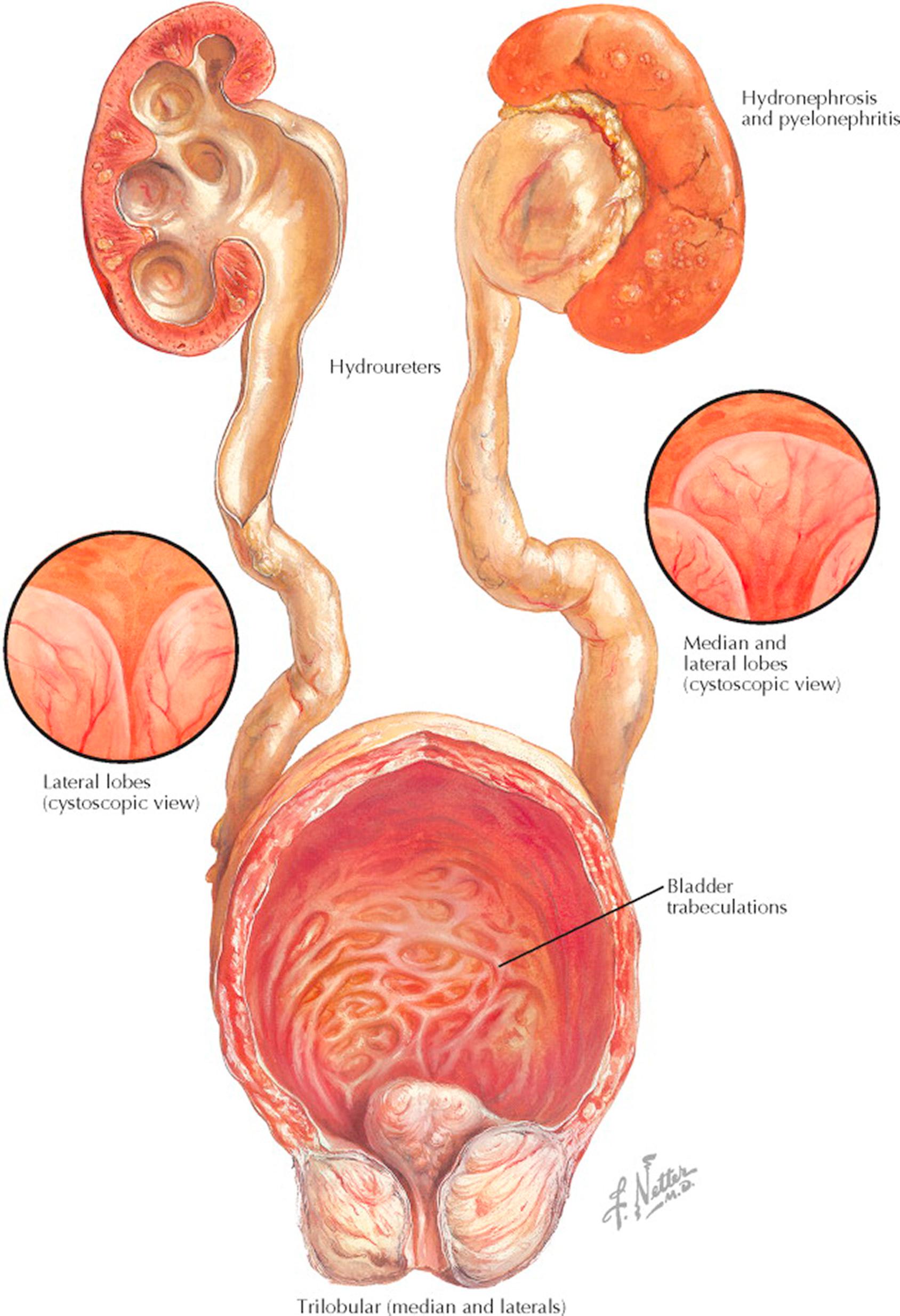
The middle or median lobe develops from 7 to 12 tubules located in the floor of the urethra proximal to the ejaculatory ducts. They are separated from the lateral tubules by connective tissue and eventually become the central and transition zones.
The posterior lobe arises from 4 to 11 tubules that appear in the third month of development and arise from the floor of the urethra distal to the seminal colliculus. They eventually contribute, along with the lateral lobes, to the posterior zone of the prostate. The acini and ducts of the posterior lobe grow posteriorly behind the ejaculatory ducts, where they are separated from other prostatic zones by a layer of fibromuscular tissue in the adult. These tubules are large and are also separated by fibrous tissue from the ejaculatory ducts. Carcinoma of the prostate (see Plate 4-10 ) develops more commonly in the posterior zone than in other prostatic regions, whereas benign hypertrophy (see Plates 4-7 through 4-9 ) originates mainly in the transition zone.
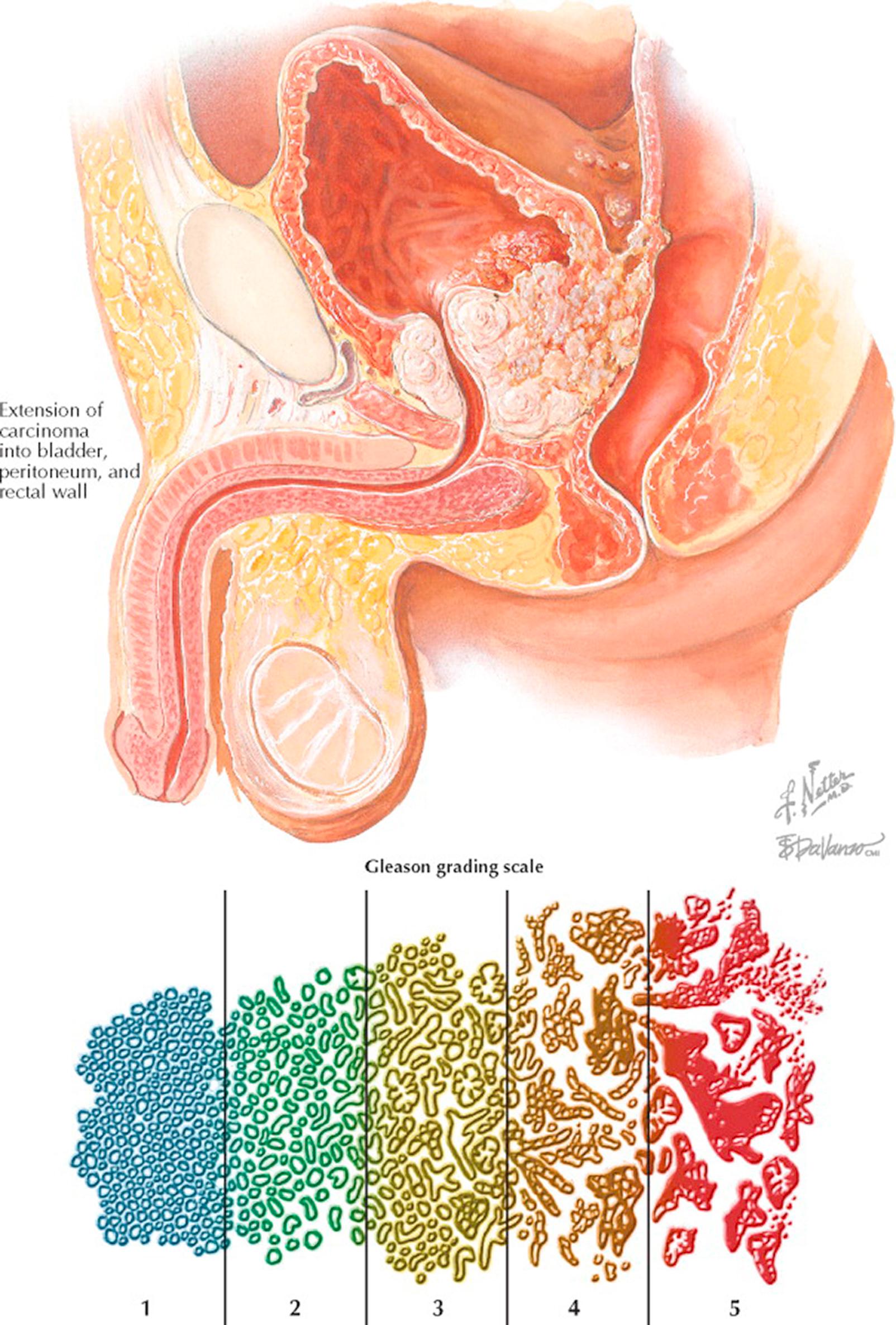
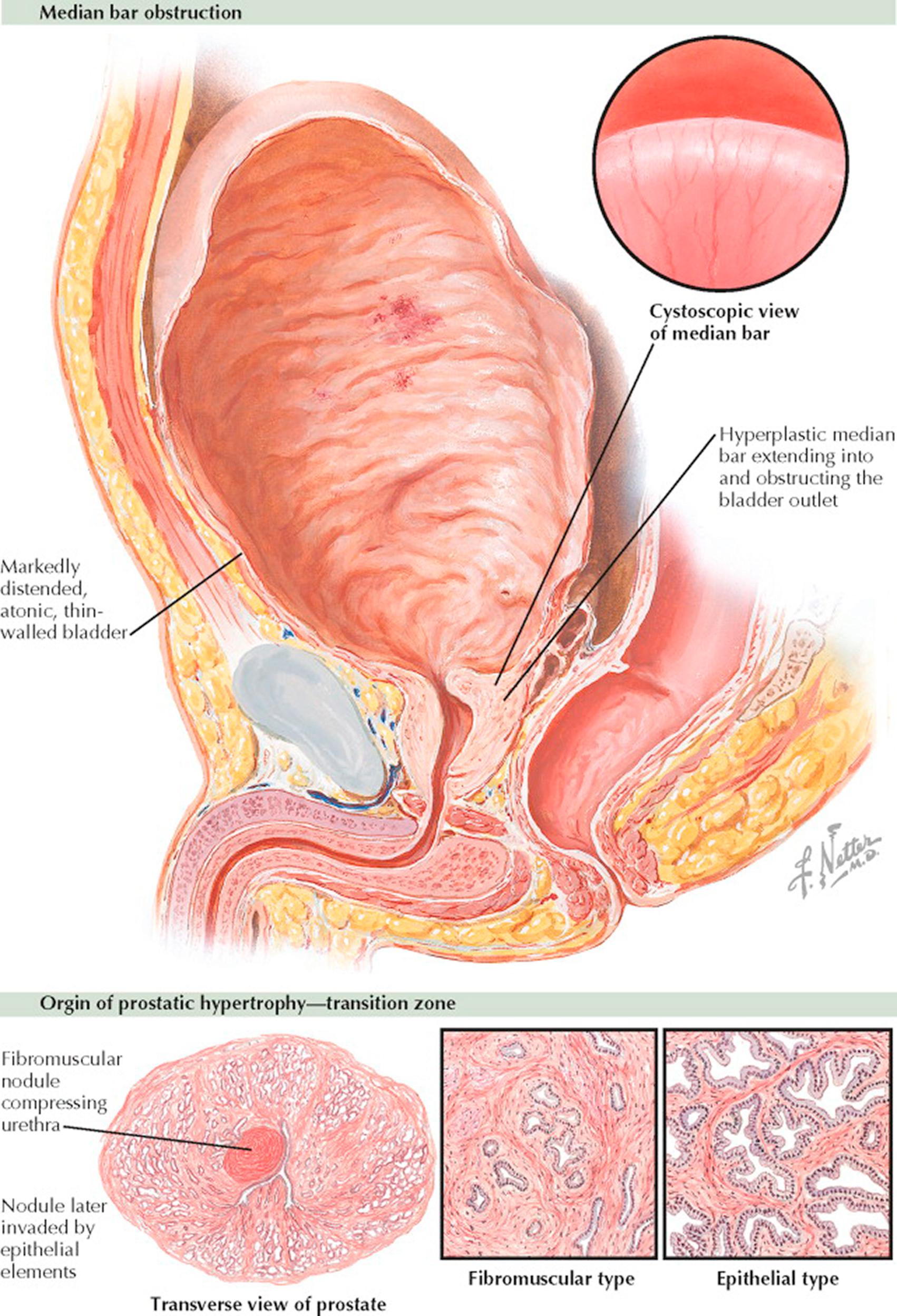

The anterior or ventral lobe consists at first of rather large and numerously branched tubules, averaging nine in number. At fetal age 16 weeks, these tubules begin to atrophy and in the newborn are reduced to a just few acini.
The eight to nineteen small tubules composing the subcervical glands of Albarrán, develop under the floor of the prostatic urethra just distal to the bladder neck. These branching tubules are short and consist of fine and cylindrical epithelia. Other small tubules may also develop under the mucosa of the trigone (glands of Home). Neither set of tubules is a common source of hypertrophy or cancer in the adult.
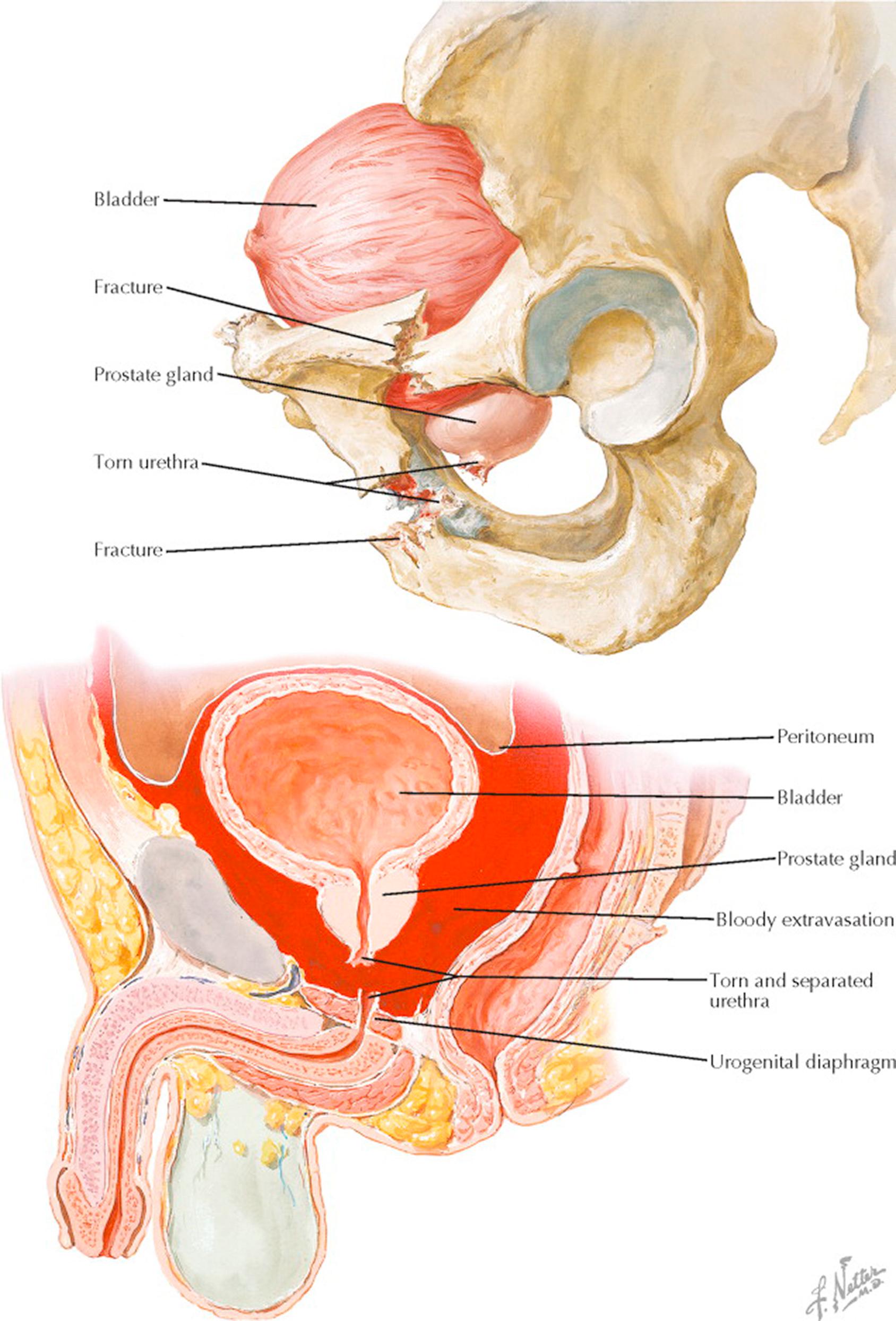
Penetrating trauma to the prostate gland is rare as it is protected from penetrating objects by the surrounding bony pelvis. However, penetrating injury to the prostate is possible from broken pelvic bones as a consequence of pelvic fracture. The real concern with prostatic trauma, however, involves injury to the posterior and prostatomembranous urethra that lie superior to the urogenital diaphragm. This is most commonly a consequence of forceful blunt trauma to the pelvis.
Posterior urethral injuries may occur in three ways: (1) Internal trauma with perforation of the membranous and prostatic urethra during unskilled use of rigid endoscopy instruments such as sounds or cystoscopes. This usually results in only temporary injury to the prostatic parenchyma but can lead to more long-term “acquired” diverticula, prostatic abscess, or prostatorectal fistula. (2) External trauma with direct injury to the prostatic capsule by either missiles or sharp objects through the perineum. Although rare, these usually involve injury to Colles fascia and to the urogenital diaphragm (see Plate 2-19 ) as well. (3) The most common and clinically important injuries involve damage to the prostatomembranous urethra from fractures of the bony pelvis. The prostate is firmly held in a relatively fixed position by the dense puboprostatic ligaments that attach its anterior surface to the under-surface of the os pubis (see Plate 4-1 ) and by its attachment by the urethra to the pelvic diaphragm inferiorly. However, the prostatomembranous urethra, measuring 1 cm long between the apex of the prostate and the urogenital diaphragm, is very fragile and easily subjected to disruption from shear force. Pelvic fracture and particularly separation of the symphysis pubis often dislocates the prostate and severs the prostatomembranous urethra from the urogenital diaphragm. Alternatively, bony os pubis fragments from the rami and ischium may sever the prostatomembranous urethra. Lastly, any injury violent enough to disrupt the puboprostatic ligaments usually also injures the prostatomembranous urethra, even with minimal bony fractures.
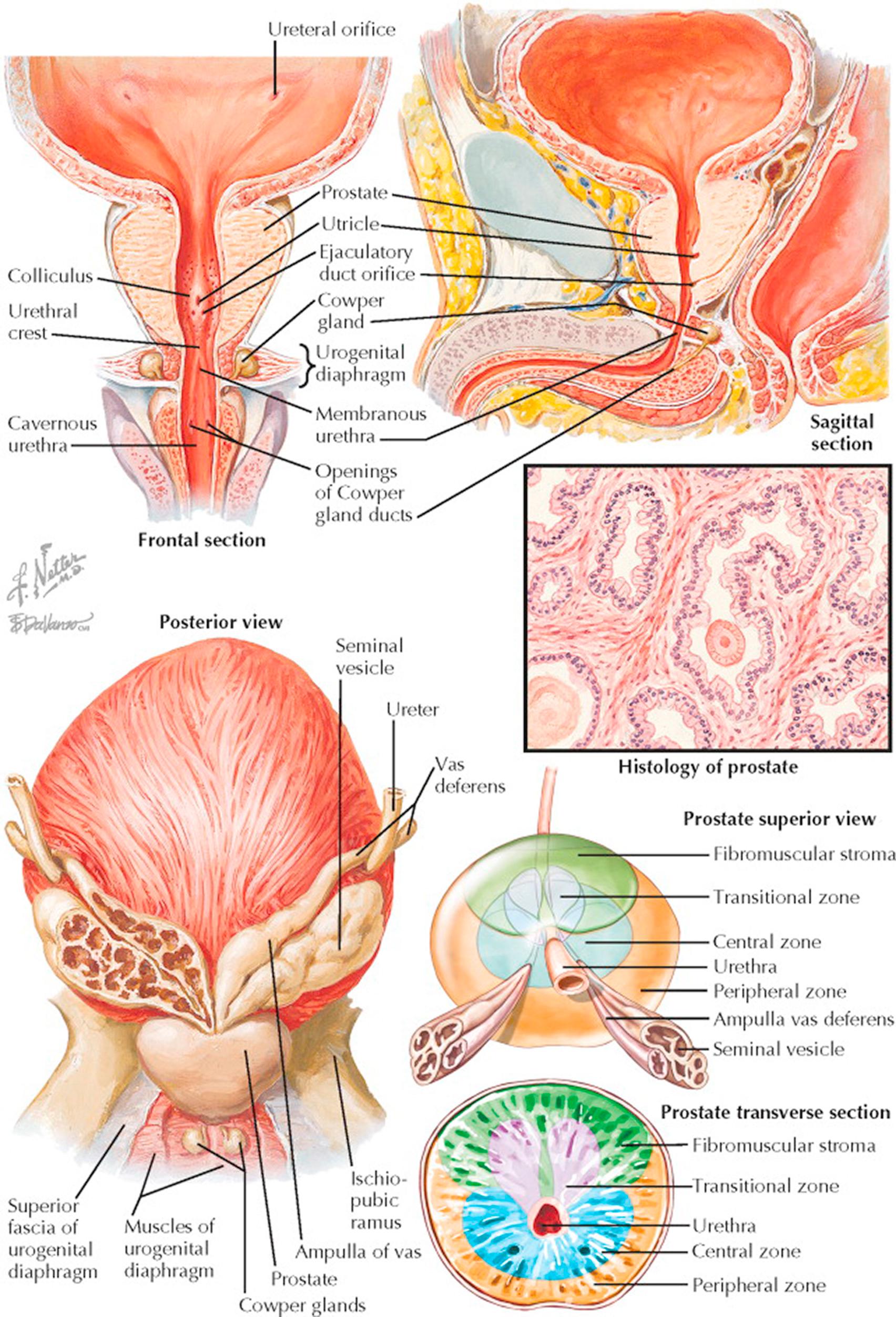
Prostatomembranous urethral rupture should be considered in all cases of trauma to the pelvic girdle. The inability to urinate and blood at the urethral meatus are particularly important symptoms and signs. A rectal examination may reveal superior displacement of the prostate from its normal position, often to the point at which it becomes nonpalpable. A retroperitoneal hematoma or urine extravasation may also accumulate and, when significant, may be palpated as a soft mass on rectal examination. Urethral catheterization should not be attempted in cases of pelvic injury and blood at the meatal tip unless retrograde urethrogram imaging reveals an intact urethra, as this procedure could convert a partial to complete urethral disruption.
The majority of posterior urethral injuries usually require urgent treatment of shock, bleeding, and fracture management. With urethral bleeding, the possibility of a coexistent intra- or extraperitoneal bladder rupture must also be considered. With an intact urethra and a small extraperitoneal bladder rupture, the simple insertion and maintenance of catheter drainage may be sufficient for early management. For intraperitoneal bladder rupture, surgical exploration and repair is generally needed.
With complete prostatomembranous urethral disruption, primary surgical reanastomosis of the urethra or primary realignment of the urethral ends over a catheter, performed immediately or in a delayed fashion, are necessary. Primary surgical repair is performed through perineal, transpubic, or suprapubic exposure and is partly determined by the limitations of patient positioning resulting from pelvic fracture and stability. Evacuation or drainage of extravasated urine is also advised. Failure to anastomose or accurately approximate the severed urethral ends leaves a mucosal defect that results in extensive cicatrix and stricture formation in the urethral gap. A significant delay in urethral realignment because of other life-threatening conditions allows a displaced prostate to become fixed by fibrous tissue, and complicates alignment surgery. In addition to urethral stricture formation, erectile dysfunction is a common complication of this form of urethral injury.
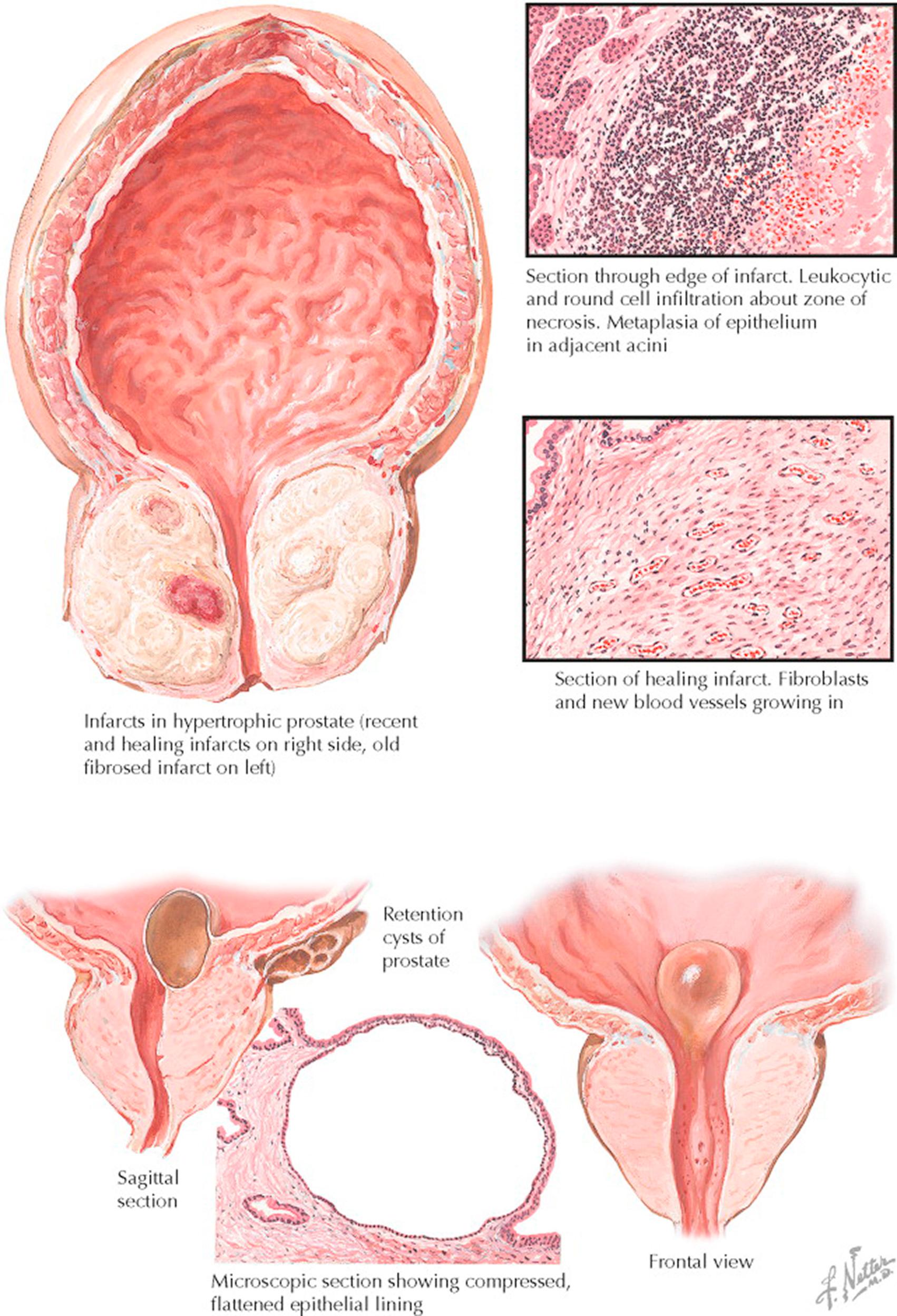
Prostatic infarction, recent or healed, is found in up to 25% of cases of benign hypertrophy when the excised glandular tissue is carefully studied. They generally produce few, if any, clinical symptoms but if large enough can mimic acute prostatitis or cause hematuria and urinary retention. The infarcted areas may be single, multiple, and up to several centimeters in size and are usually located around the periphery of an area of prostatic hyperplasia within the transition zone. They occur more often with significant hyperplasia and in instrumented patients, although they can occur without obvious cause or infection. Prostatic infarcts are thought to be due to arterial obstruction from enlarging hyperplastic nodules, infection, or inflammation on the urethral branches of the prostatic artery (see Plate 2-6 ).
Grossly, prostatic infarcts show mottled yellowish areas surrounded by a hemorrhagic margin. Within the area of infarction, the tissue loses its normal structure and becomes necrotic. Acutely, swelling and edema compress the surrounding acini. Interestingly, with infarction the epithelium of the immediately surrounding acini may be altered, in which normal cells are replaced by polygonal and sometimes squamous cells. This multiplication of cell layers often fills and obliterates the lumen of the adjacent acinus. Histologically, these cells lack characteristics of metaplasia, including keratinization and intercellular bridges, and therefore more closely resemble regenerative dysplastic cells than squamous epithelium. These marginal changes are not malignant or precancerous and should not be considered squamous cell carcinoma.
Prostatic cysts occur in 10% of adult men and generally have little clinical significance. They can be congenital due to müllerian or wolffian ducts remnants. Other cysts may be of parasitic origin from schistosomiasis or Echinococcus infection. Hemorrhagic cysts can occur within degenerating areas of advanced prostatic carcinoma. The common prostatic cyst is a simple retention cyst that arises from prostatic acini, generally beneath the trigone. They are likely a consequence of obstructed acini and can be multilobular from rupture of the thin walls between adjacent obstructed acini. Such cysts may project into the urethra or into the bladder neck. When located near the gland periphery, they may be palpable on rectal exam as soft, fluctuant masses. Prostatic retention cysts of 6 to 8 mm diameter are not uncommon but larger cysts up to several centimeters in size are relatively rare and can be symptomatic.
Prostatic cysts are lined by thin, flattened, columnar epithelia. When they project into the bladder or urethra, they are covered with the mucous epithelium of the surrounding structure. Cyst contents on aspiration appear thin and milky. Symptomatic cysts that project into the prostatic urethra or the bladder neck are easily removed by transurethral resection.
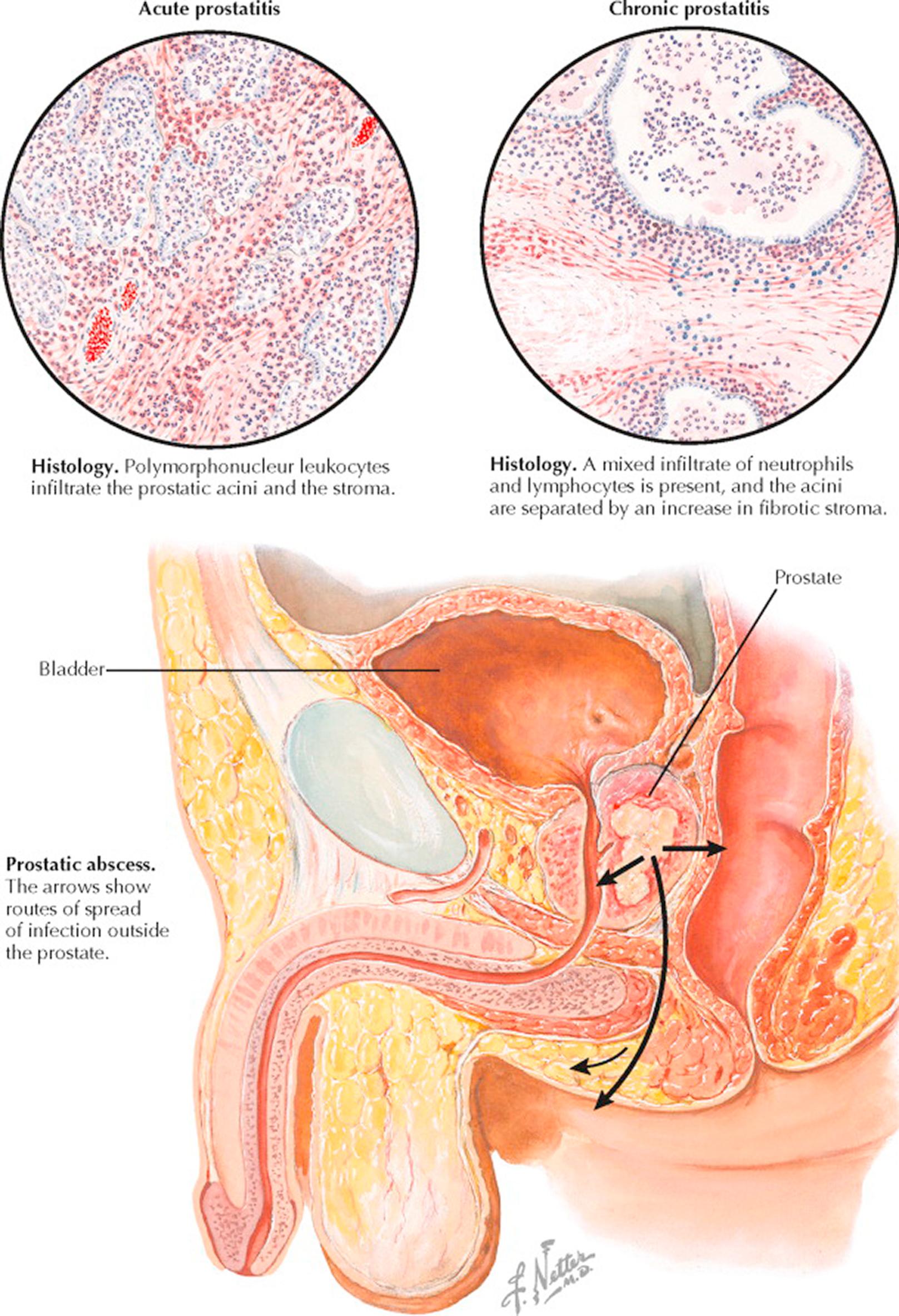
Prostatitis is the term given to a complex constellation of symptoms and findings related to the prostate. Currently, there are four general categories of clinically defined prostatitis. They are differentiated based on symptoms and the urinalysis findings of bacteruria and pyuria. The categories are acute bacterial (NIH Class I), chronic bacterial (NIH Class II), inflammatory (NIH Class IIIA) or noninflammatory (NIH Class IIIB), and asymptomatic inflammatory prostatitis (NIH Class IV). Class III prostatitis is also termed chronic nonbacterial prostatitis/chronic prostatitis and pelvic pain syndrome (CPPS).
Acute bacterial prostatitis typically presents with acute urinary tract infection (UTI) symptoms and infected urine, typically with gram-negative organisms. It is unusual but may be related to urologic instrumentation and chronic catheter use. Clinically, it involves the acute onset of irritative voiding symptoms, dysuria, pelvic and perineal pain, fever, and hematuria. Not uncommonly, a rectal exam reveals a tender, “boggy” prostate. Cloudy, infected urine is a feature that differentiates it from prostatic infarction. Histologically, prostatic acini are filled with exudate, and the stroma is infiltrated with leukocytes. When severe, urinary retention may result, which is treated with urethral or suprapubic catheter drainage. The infection requires broad-spectrum, gram-negative antibiotics that are later adjusted to bacterial sensitivity.
Chronic bacterial prostatitis can occur with or without an antecedent acute form and is characterized by acute or chronic symptoms and infected urine. Patients experience recurrent episodes of bacterial UTI caused by the same organism, usually Escherichia coli , another gram-negative organism, or enterococcus. Between symptomatic episodes, lower urinary tract cultures can document an infected prostate gland as the focus of recurrent infections. Indwelling catheters, instrumentation, recurrent UTIs, bladder stones, or spread from distant infections such as abscessed teeth, bronchitis, pneumonia, or sinusitis may underlie this diagnosis. Chronic prostatitis can be asymptomatic but is usually associated with complaints of scrotal, penile, low back, inguinal, or perineal pain; sexual dysfunction; and irritative or obstructive urinary symptoms. The finding of a boggy or fluctuant prostate on rectal examination is unusual. Histologically, prostatic acini contain increased leukocytes and the stroma is infiltrated with plasma cells and varying degrees of fibrosis. Prostatic ducts can also be chronically inflamed and dilated, indicating an infection that extends from the urethra.
Class III inflammatory or noninflammatory prostatitis is not primarily a disease of the prostate or the result of an inflammatory process but is a moniker for a symptom complex suggestive of bacterial prostatitis but in the absence of bacteruria. More than 90% of symptomatic patients fall into this category of prostatitis. Symptom duration and intensity can be significant and can be associated with profound impacts on patient quality of life. Pyuria can be present (IIIA) or absent (IIIB) in the urine, semen, or in the urethral fluid obtained after expressed prostatic massage. Urologic pain complaints are the primary component of this syndrome, and exclusion criteria include the presence of active urethritis, urogenital cancer, urinary tract disease, functionally significant urethral stricture, or neurologic disease affecting the bladder. This prostatitis category recognizes the limited understanding of the causes of this syndrome and the possibility that organs other than the prostate gland may be causally important.
Asymptomatic inflammatory prostatitis is diagnosed in patients without a history of genitourinary tract pain complaints. The diagnosis is made during evaluation of other genitourinary tract issues, including (1) the finding of inflammation on a prostate biopsy for possible prostate cancer because of an elevated serum prostate-specific antigen (PSA) level and (2) elevated leukocytes in the seminal fluid of infertility patients (pyospermia). Treatment is aimed at decreasing PSA levels or restoring normal semen quality, as pain is not a component of this diagnosis.
Prostatic abscess as a consequence of acute prostatitis is unusual with modern antibiotic therapy. Abscess can occur with metastasis from distant infectious foci or as a complication of immunosuppressive disease. Symptoms are similar to those of acute prostatitis, but stranguria and tenesmus are more common, along with acute urinary retention. Prostatic abscess can sometimes be detected on rectal examination with the finding of a boggy and tender gland. If untreated, the abscess usually spares rectal involvement due to Denonvilliers fascia posteriorly, but rupture and drainage into the posterior urethra is possible. Treatment with incision and drainage through endoscopic unroofing or transrectal or perineal drainage may be required along with appropriate antibiotics.

Tuberculous prostatitis is rare, but the gland is infected in about one of eight patients who die from tuberculosis. Tuberculous prostatitis is observed in 75% to 90% of tuberculosis involving the genitourinary tract. If the infection is confined to the genitourinary tract, the prostate and seminal vesicles are involved in 100% of cases, whereas epididymitis occurs in about 60% of cases. Most affected men (80%) are less than 50 years old. It is generally assumed that tuberculous prostatitis develops secondary to active tuberculosis elsewhere in the body and through a hematogenous route.
Of men with prostatic tuberculosis, 50% have dysuria and 40% have perineal pain. Patients may also present with male infertility, a well-described complication of prostatic tuberculosis. Sterile urethral discharge or pyuria and terminal hematuria may also be associated with this condition. Rarely, perineal swelling, drainage, and urinary fistula comprise the most overt presentation. Tuberculous prostatitis may also be painless and may remain undiscovered except when palpated by rectal examination in cases of urinary tract or epididymal tuberculosis. When the prostate is involved, its palpation may reveal a normal or enlarged gland that is irregular or nodular in contour, and firm or granular in consistency. Soft areas can be palpated when caseation is present. Tuberculosis in the prostate does not differ from that encountered elsewhere in the body. Histologically, there is destruction of normal glandular tissue and replacement by a crumbly, yellow mass of caseous material surrounded by fibrous capsules. Healing proceeds with fibrosis and calcification. After antibiotic treatment, the prostate may become fibrotic.
Prostatic calculi may be found with or without glandular hyperplasia. They contain protein, cholesterol, citrates, and inorganic salts, mostly calcium and magnesium phosphate. Most cases are encountered in patients more than 40 years old. Calculi are located diffusely within dilated acini and this distribution can, though not necessarily, be associated with other pathologic findings, such as prostatitis. It is difficult to establish whether conditions precede the formation of calculi or vice versa. The symptoms and urinary findings in cases of calculi are characteristic of chronic prostatitis and not usually due to the presence of calculi alone. However, calculi may be the source of recurrent prostatitis if bacterial infection cannot be cleared in their presence.
Calculi that occur at the junction of the transition and posterior zones of the prostate are called corpora amylacea and are common in patients with benign enlargement of the prostate. They are thought to occur because as prostatic secretions become “inspissated” from the disarray of the duct architecture from benign prostatic hyperplasia they eventually calcify. The diagnosis is usually made when calcifications are visualized on transrectal ultrasound imaging. On rare occasions, calculi protrude into the posterior urethra from the orifice of a prostatic duct and grow into a urethral calculus. In most cases, prostatic calculi are not specifically treated as they are incidental findings from prostatic imaging.
Benign prostatic hyperplasia (BPH) is a benign condition of advancing years affecting one-third of men age 50, more than half of men at age 65, and 80% of men in their ninth decade. It may or may not result in voiding symptoms, generally obstructive in nature. In about 15% of cases, symptoms are sufficiently severe or obstructive uropathy ensues that requires surgical intervention. A clear association between BPH and prostate cancer has not been demonstrated and the former is not considered a risk factor for development of the latter.
The term benign prostatic hyperplasia (often termed hypertrophy ) is currently used to designate a constellation of voiding symptoms that occurs with age, regardless of prostatic histopathology. These symptoms include decreased force of stream, hesitancy, straining, incomplete bladder emptying, and nocturia. Such symptoms are generally referred to as “obstructive” in nature. Irritative symptoms can also be associated with BPH and include urinary frequency, urgency, and occasionally dysuria. BPH has been used synonymously with “prostatism” and “bladder outlet obstruction,” implying that obstruction to urinary outflow from prostatic enlargement is the etiology. More recently, it has been recognized that prostatic enlargement is not necessary for such symptoms. Furthermore, women may experience similar symptoms with age. Thus, lower urinary tract symptoms is currently the preferred term to describe the complex of urinary symptoms that occur with age.
Histologically confirmed BPH has a neoplastic character, with nodular lesions located throughout the transition zone of the prostate that may grow without limit. These nodules consist of distinct tissue types and do not represent diffuse hyperplasia or hypertrophy of preexisting prostatic glands. Early lesions consist of fibromyomas that represent proliferation of smooth muscle and connective tissue surrounding the ducts of the urethral and submucosal glands. The fibromyomatous structure is similar to that of uterine myomas (see Plate 8-25 ), except that prostate nodules usually contain epithelial elements arising from invasion of epithelial buds from adjacent prostatic ducts. Early nodules may vary from pure fibromuscular tissue with little or no epithelial component to adenomas in which epithelial elements are profusely found. The fibromuscular stroma lacks the elastic tissue present in the normal prostate. The epithelial elements are composed of hyperplastic columnar cells that form numerous enfolding papillae and are morphologically similar to those of the normal prostate, except with reduced secretory activity. The vast majority of nodules arise in a well-defined area in periductal tissue of the short urethral and submucosal glands within the transition zone. However, adenomas may also originate in the fibromuscular stroma surrounding the acini of the central and, rarely, the anterior zone of the prostate rather than the usual periurethral site. Hyperplasia is highly unusual in the posterior zone.
As the nodules grow, they compress the normal acini of the peripheral zone into a thin rim of tissue between the growing hyperplastic nodule and the prostatic capsule. These compressed “normal” glands, sometimes only 1 mm thick, comprise the so-called surgical (false) capsule, which is not the same as the true fibrous capsule that surrounds the entire prostate. On microscopic examination, the ducts and acini of the peripheral zone are flattened and compressed.
Benign prostatic hyperplasia can adopt a number of different configurations that result in urinary symptoms. One variety that presents with the early onset of voiding symptoms is median bar or bladder neck hyperplasia, which consists of exuberant growth of fibromuscular tissue near the bladder outlet. The tissue may be more fibrotic than muscular and may contain hyperplastic epithelial elements originating from the suburethral glands of Albarrán (see Plate 4-2 ) beneath the bladder outlet. The obstructing median bar is not palpable on rectal examination but is suspected from obstructive symptomatology. The diagnosis is confirmed by direct visualization through the cystoscope. Depending on symptom severity, treatment can begin with daily alpha-blockers or with transurethral endoscopic incision of the bladder neck.
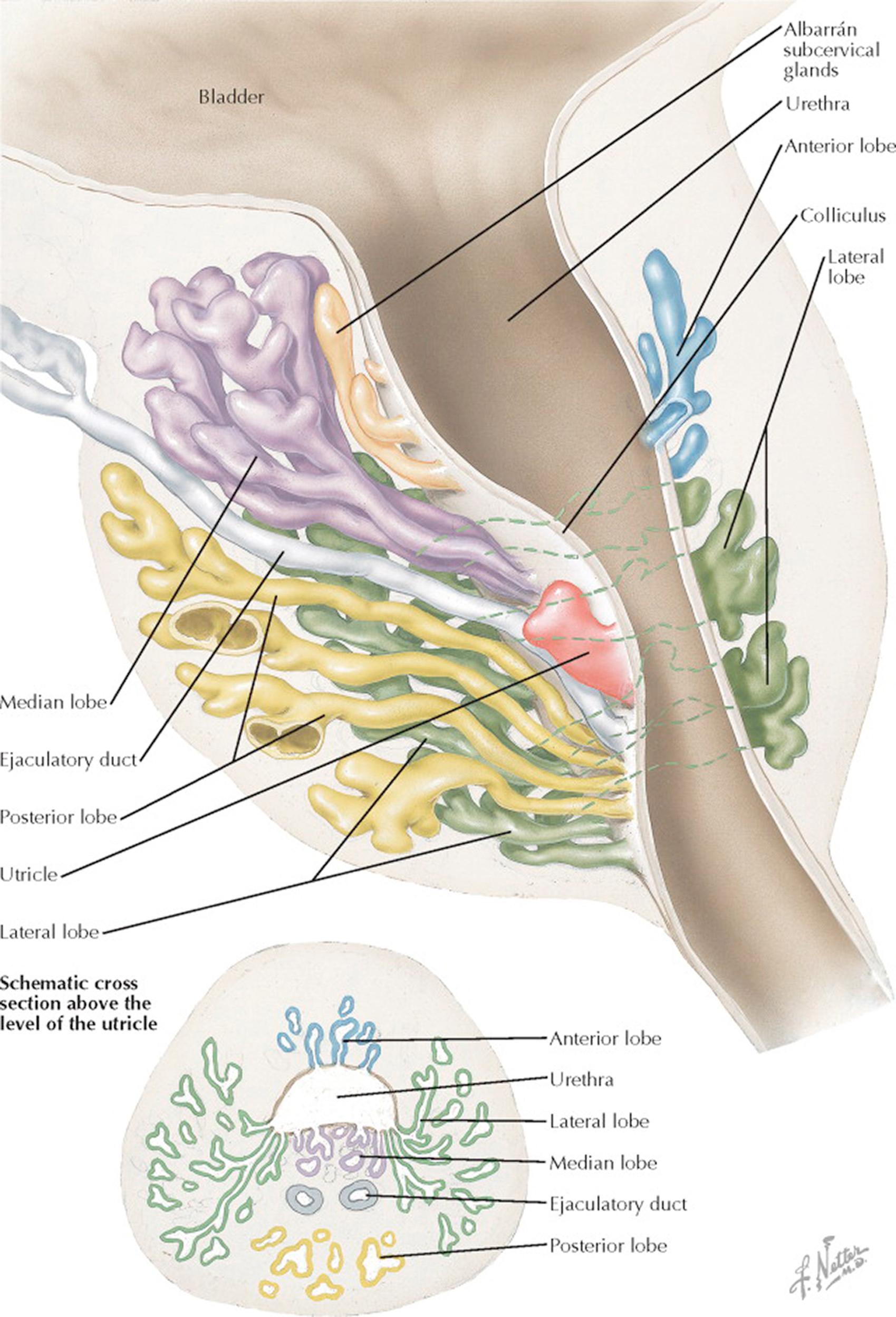
Become a Clinical Tree membership for Full access and enjoy Unlimited articles
If you are a member. Log in here